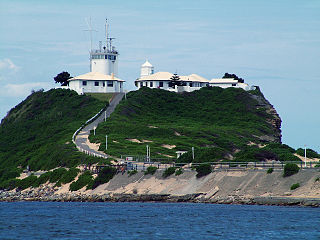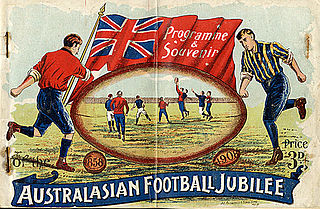
New South Wales is a state on the east coast of Australia. It borders Queensland to the north, Victoria to the south, and South Australia to the west. Its coast borders the Coral and Tasman Seas to the east. The Australian Capital Territory is an enclave within the state. New South Wales' state capital is Sydney, which is also Australia's most populous city. In June 2020, the population of New South Wales was over 8.1 million, making it Australia's most populous state. Just under two-thirds of the state's population, 5.3 million, live in the Greater Sydney area. The demonym for inhabitants of New South Wales is New South Welshmen.

The Newcastle metropolitan area is the second most populated area in the Australian state of New South Wales. It includes the Newcastle and Lake Macquarie local government areas. It is the hub of the Greater Newcastle area, which includes most parts of the local government areas of City of Newcastle, City of Lake Macquarie, City of Cessnock, City of Maitland and Port Stephens Council.
The emu is a large, flightless bird.
Brighton is a town in East Sussex and constituent part of the city of Brighton and Hove.

Waratah (Telopea) is an Australian-endemic genus of five species of large shrubs or small trees, native to the southeastern parts of Australia. The most well-known species in this genus is Telopea speciosissima, which has bright red flowers and is the NSW state emblem. The Waratah is a member of the plant family Proteaceae, a family of flowering plants distributed in the Southern Hemisphere. The key diagnostic feature of Proteaceae is the inflorescence, which is often very large, brightly coloured and showy, consisting of many small flowers densely packed into a compact head or spike. Species of waratah boast such inflorescences ranging from 6–15 cm in diameter with a basal ring of coloured bracts. The leaves are spirally arranged, 10–20 cm long and 2–3 cm broad with entire or serrated margins. The name waratah comes from the Eora Aboriginal people, the original inhabitants of the Sydney area.

The Main North Line is a major railway in New South Wales, Australia. It runs through the Central Coast, Hunter and New England regions. The line was the original main line between Sydney and Brisbane, however this required a change of gauge at Wallangarra. As of 1988, the line closed progressively north of Armidale with services gradually withdrawn till 2004, with the main route between Sydney and Brisbane now the North Coast line.

Waratah is a north-western residential suburb of Newcastle, New South Wales, Australia, 6 kilometres (3.7 mi) from Newcastle's central business district and bounded to the north by the Main North railway line. Waratah station was opened in 1858 and is served by NSW TrainLink's Hunter line.

Telopea speciosissima, commonly known as the New South Wales waratah or simply waratah, is a large shrub in the plant family Proteaceae. It is endemic to New South Wales in Australia and is the floral emblem of that state. No subspecies are recognised, but the closely related Telopea aspera was only recently classified as a separate species.

Timana James Aporo Tahu is an Australian former professional rugby league and rugby union footballer. He last played for Denver Stampede in the US PRO Rugby competition. A dual-code international representative three-quarter back for Australia's Kangaroos and then the Wallabies, he could also play second-row and played for New South Wales in State of Origin. Tahu started his career in the National Rugby League for the Newcastle Knights, with whom he won the 2001 NRL Premiership before moving to the Parramatta Eels. He then played for the New South Wales Waratahs in the Super Rugby competition. Tahu returned to the NRL with the Eels and then the Penrith Panthers before finishing his NRL career where it started with the Newcastle Knights.
The railways of New South Wales, Australia, use a large variety of passenger and freight rolling stock. The first railway in Sydney was opened in 1855 between Sydney and Granville, now a suburb of Sydney but then a major agricultural centre. The railway formed the basis of the New South Wales Government Railways. Passenger and freight services were operated from the beginning. By 1880, there was a half hourly service to Homebush.

Kooragang is the northernmost and largest suburb of the city of Newcastle, in the Hunter Region of New South Wales, Australia. Dominated by Kooragang Island, the eastern part of the suburb is primarily industrial, while the western part of the suburb consists of nature reserves. Covering an area of 35.4 km2 (13.7 sq mi), at the 2016 census, there were no people living in the suburb.
The following lists events that happened during 1864 in Australia.

The 1908 Melbourne Carnival was the inaugural Australian National Football Carnival, an Australian rules football interstate competition, held in Melbourne in August 1908. It was known at the time as the Jubilee Australasian Football Carnival because it was designed to commemorate 50 years of Australian rules football.

This article contains a list of jargon used to varying degrees by railfans, trainspotters, and railway employees in Australia, including nicknames for various locomotives and multiple units. Although not exhaustive, many of the entries in this list appear from time to time in specialist, rail-related publications. There may be significant regional variation in usage; state variances may be indicated by the state abbreviation.

This article details the history of Newcastle, New South Wales from the first human activity in the region to the 20th century.

Telopea truncata, commonly known as the Tasmanian waratah, is a plant in the family Proteaceae. It is endemic to Tasmania where it is found on moist acidic soils at altitudes of 600 to 1200 m (2000–4000 ft). Telopea truncata is a component of alpine eucalypt forest, rainforest and scrub communities. It grows as a multistemmed shrub to a height of 3 metres (10 ft), or occasionally as a small tree to 10 m (35 ft) high, with red flower heads, known as inflorescences, appearing over the Tasmanian summer and bearing 10 to 35 individual flowers. Yellow-flowered forms are occasionally seen, but do not form a population distinct from the rest of the species.
A showground is a places where events occur, including agricultural shows, and associated facilities. In Australia, New Zealand and the United States, showgrounds often house dirt track speedways.











